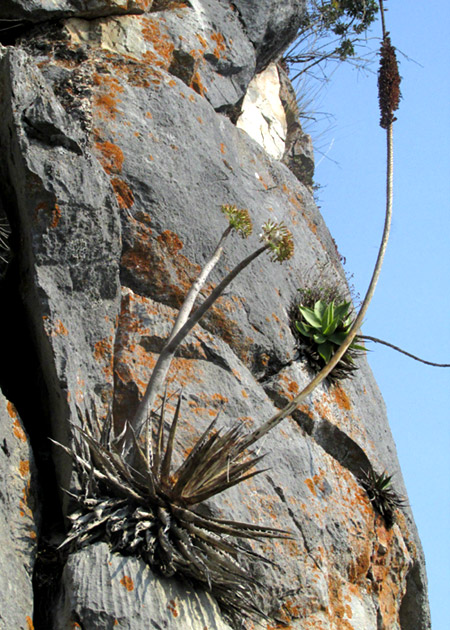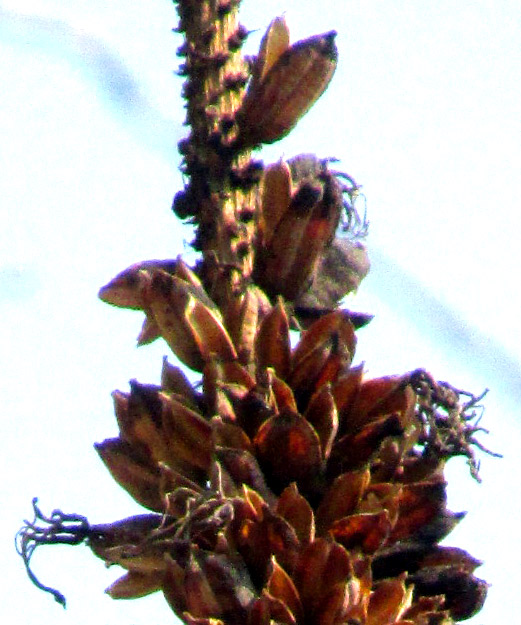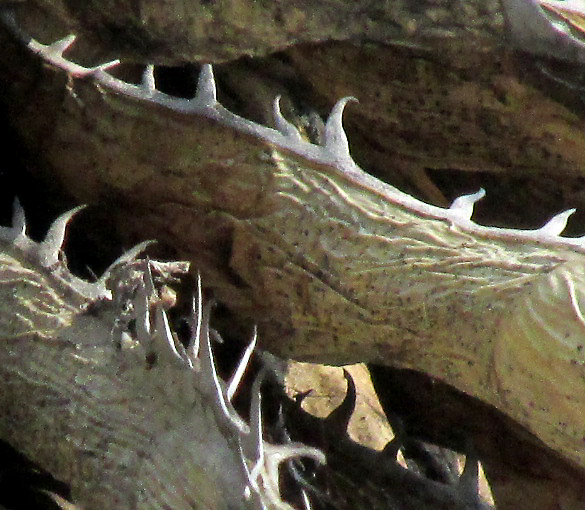Excerpts from Jim Conrad's
Naturalist Newsletter
entry from field notes dated May 5, 2023, taken about 150m uphill on NE-facing slope, above intersection of road from Hwy 120 to San Joaquín, with road to El Doctor; juniper and pine forest on limestone bedrock; elevation ±2425m (7950 ft); Eastern Sierra Madre mountains of east-central Querétaro state, MÉXICO, (N20.88°, W99.62°)
AMERICAN ALOE

Three interesting flowering plants issue from fissures in the high limestone wall pictured above. The fork-trunked one whose branches are tipped with yellowish flowers amid white fuzz is a Broomstick Tree. The rosette of green, sharp-pointed blades in the background is a maguey de peña, an agave. The plant being profiled here is another agave, the one in the foreground, with dried-up, grayish blades and an arcing spike of past-mature, capsule-type fruits that already have dispersed their seeds. This agave is dead because -- as with most agave species -- it grows perhaps for several or many years, then blossoms, and dies. In most species, sprouts from the base continue to live as the flowering part dies.
At first I thought that these were the commonly encountered agave known as lechuguillas. However, the fruiting heads seemed to produce many more capsular fruits more densely packed than lechuguillas. The plants grew well above my head so a small telephoto lens was used for a closer look:

You can see that the capsules split along three sutures, and that some still bear dried-up stigmas attached at their tips. The above picture may have revealed our plant's identity to an expert, but I thought maybe our plant was just an exceptionally robust lechuguilla. Fortunately, a telephoto look at the dead, shriveled blades showed something that even I thought was wrong for a lechuguilla:

Without getting close it was hard to judge the spines' size, but they seemed much larger, closer together, and much more irregular in size, nearness to another, shape, and direction in which they pointed than lechuguilla. Also, notice that blade margins are somewhat thickened and white.
There's no comprehensive treatment of agaves of this area or Mexico, and in general the taxonomy of the group is very confused. Partly that's because collecting herbarium specimens of such tough, spiny-margined plants is a problem, and often years pass before an agave flowers and fruits. Also, early botanists provided poor descriptions of the plants they named, often having seen only non-flowering or -fruiting plants. Agave identification can be very hard, sometimes impossible.
Therefore, I was fortunate to find a 2016 study by Jordi López-Pujol and others entitled Primera Cita del Endemismo Mexicano Agave difformis A. Berger (Agavaceae) fuera de su Área de Distribución Native, detailing the discovery and naming of an invasive agave species in Spain that at first sight looked like a lechuguilla, but wasn't.
For López-Pujol's team the identification process began by noting that around 200 Agave species are native only to the Americas, from the US south to Venezuela, plus the Caribbean. About 85 Agave species are cultivated in the Iberian Peninsula, and some 9 have become invasive, apparently escaped from gardens. Agaves easy to confuse with the common lecheguilla are the closely related Agave difformis and Agave funkiana. Both naturally occur in our area.
López-Pujol's team decided that their escaped agave was Agave difformis. First, their plants averaged somewhat larger than lecheguillas. Second, spines on their plants grew larger and were more polymorphic than on the other two species -- generally much less consistent in their size, distance between one another, and the direction the tips pointed. Also, the blades' slender, white margins are special to Agave difformis. Our limestone wall plant looks just like the one escaped in Spain, so it's AGAVE DIFFORMIS.
The natural distribution of Agave difformis is just the Eastern Sierra Madre mountains of upland eastern Mexico. You can see where they've been documented on the GBI Agave difformis page.
Agave difformis, despite its limited natural distribution, often is sold in various countries as a potted plant and for gardens. Sometimes it's named American Aloe, though it's not an aloe. Aloes belong to the genus Aloe, not Agave. A physical feature causing Agave difformis to bring to mind an aloe is that our agave's flowering and fruiting stem is thicker than usual. Also, the flowers and fruits are much more densely compacted and almost appear to spiral around the stalk, as with the aloes. Flowers of most agave species can be seen as grouped in twos or threes, not densely spiraling.
This was a good find. I'll bet lots of these plants are overlooked by people thinking they're just another lechuguilla.